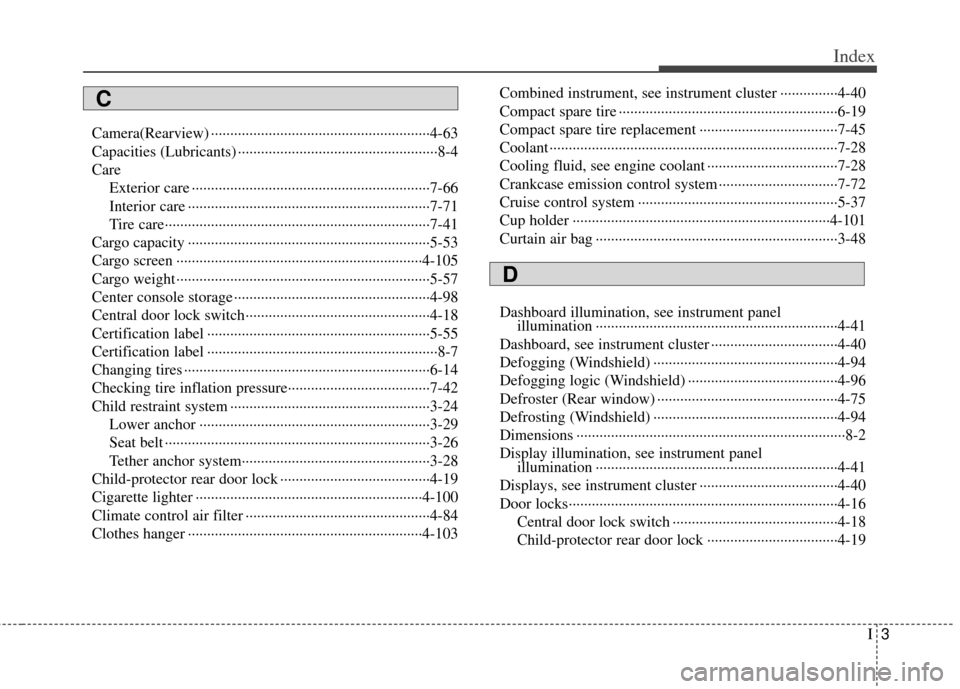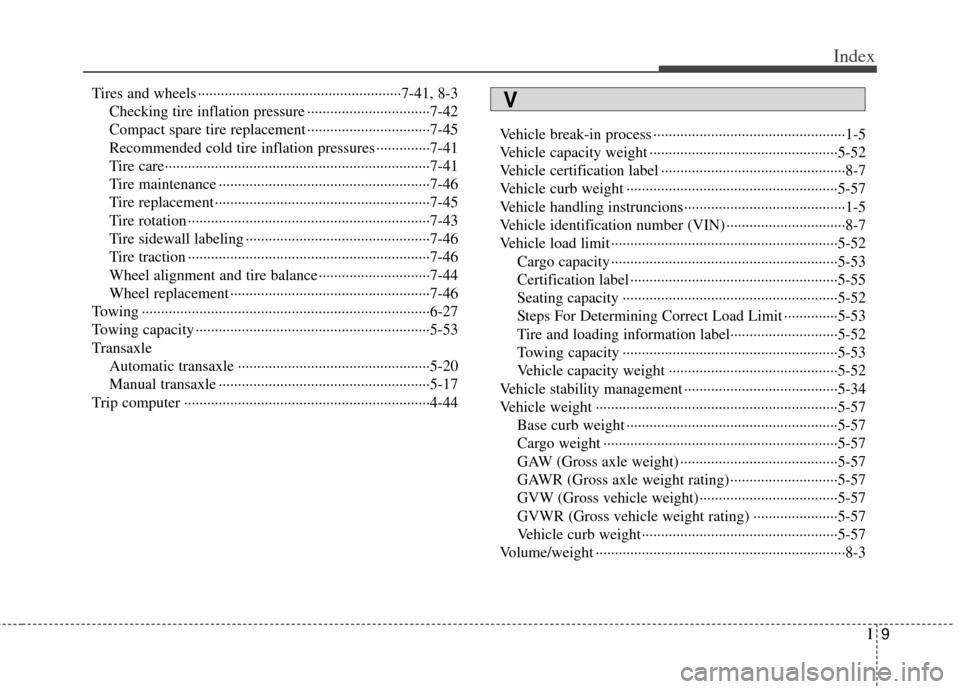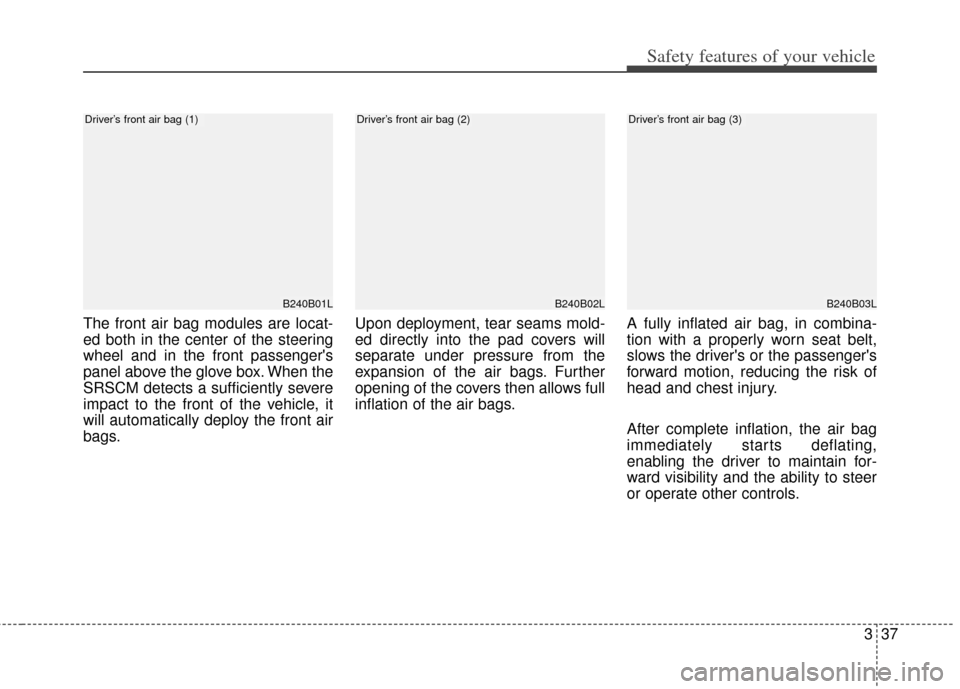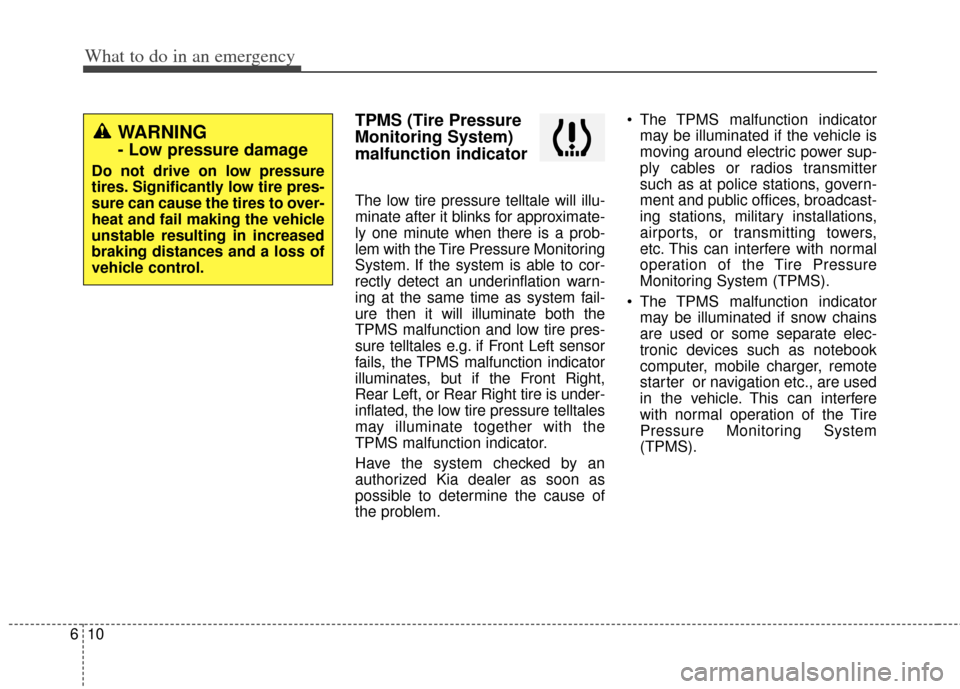inflation pressure KIA Soul 2013 1.G Owner's Manual
[x] Cancel search | Manufacturer: KIA, Model Year: 2013, Model line: Soul, Model: KIA Soul 2013 1.GPages: 393, PDF Size: 8.76 MB
Page 6 of 393

I3
Index
Camera(Rearview) ··················\
··················\
··················\
···4-63
Capacities (Lubricants) ··················\
··················\
················8-4
CareExterior care ··················\
··················\
··················\
········7-66
Interior care ··················\
··················\
··················\
·········7-71
Tire care··················\
··················\
··················\
···············7-41
Cargo capacity ··················\
··················\
··················\
·········5-53
Cargo screen ··················\
··················\
··················\
··········4-105
Cargo weight ··················\
··················\
··················\
············5-57
Center console storage ··················\
··················\
···············4-98
Central door lock switch··················\
··················\
············4-18
Certification label ··················\
··················\
··················\
····5-55
Certification label ··················\
··················\
··················\
······8-7
Changing tires ··················\
··················\
··················\
··········6-14
Checking tire inflation pressure··················\
··················\
·7-42
Child restraint system ··················\
··················\
················3-24 Lower anchor ··················\
··················\
··················\
······3-29
Seat belt ··················\
··················\
··················\
···············3-26
Tether anchor system··················\
··················\
·············3-28
Child-protector rear door lock ··················\
··················\
···4-19
Cigarette lighter ··················\
··················\
··················\
·····4-100
Climate control air filter ··················\
··················\
············4-84
Clothes hanger ··················\
··················\
··················\
·······4-103 Combined instrument, see instrument cluster ···············4-40
Compact spare tire ··················\
··················\
··················\
···6-19
Compact spare tire replacement ··················\
··················\
7-45
Coolant ··················\
··················\
··················\
··················\
···7-28
Cooling fluid, see engine coolant ··················\
················7-28
Crankcase emission control system ··················\
·············7-72
Cruise control system ··················\
··················\
················5-37
Cup holder ··················\
··················\
··················\
·············4-101
Curtain air bag ··················\
··················\
··················\
·········3-48
Dashboard illumination, see instrument panel
illumination ··················\
··················\
··················\
·········4-41
Dashboard, see instrument cluster ··················\
···············4-40
Defogging (Windshield) ··················\
··················\
············4-94
Defogging logic (Windshield) ··················\
··················\
···4-96
Defroster (Rear window) ··················\
··················\
···········4-75
Defrosting (Windshield) ··················\
··················\
············4-94
Dimensions ··················\
··················\
··················\
················8-2
Display illumination, see instrument panel illumination ··················\
··················\
··················\
·········4-41
Displays, see instrument cluster ··················\
··················\
4-40
Door locks··················\
··················\
··················\
················4-16 Central door lock switch ··················\
··················\
·······4-18
Child-protector rear door lock ··················\
················4-19
D
C
Page 10 of 393

I7
Index
Mirrors ··················\
··················\
··················\
··················\
···4-36Day/night rearview mirror ··················\
··················\
····4-36
Electric chromic mirror ··················\
··················\
·········4-36
Inside rearview mirror··················\
··················\
···········4-36
Outside rearview mirror ··················\
··················\
········4-37
Multi box ··················\
··················\
··················\
·················4-99\
Occupant detection system ··················\
··················\
········3-38
Odometer ··················\
··················\
··················\
·················4-43\
Oil (Engine) ··················\
··················\
··················\
·············7-26
Outside rearview mirror··················\
··················\
·············4-37
Outside temperature ··················\
··················\
··················\
·4-48
Overheats ··················\
··················\
··················\
··················\
·6-7
Owner maintenance ··················\
··················\
··················\
···7-6
Parking brake ··················\
··················\
··················\
···········5-26
Parking brake ··················\
··················\
··················\
···········7-33
Power brakes··················\
··················\
··················\
············5-25
Power outlet ··················\
··················\
··················\
···········4-102
Power window lock button ··················\
··················\
········4-24
Pre-tensioner seat belt··················\
··················\
················3-19
Push starting··················\
··················\
··················\
···············6-6 Rear seat··················\
··················\
··················\
··················\
·3-10
Rearview camera ··················\
··················\
··················\
·····4-63
Recommended cold tire inflation pressures ··················\
7-41
Recommended lubricants and capacities ··················\
·······8-4
Recommended SAE viscosity number··················\
······8-6
Refrigerant label ··················\
··················\
··················\
········8-8
Remote keyless entry ··················\
··················\
··················\
·4-6
Road warning ··················\
··················\
··················\
·············6-2
Rocking the vehicle ··················\
··················\
··················\
·5-45
Roof antenna ··················\
··················\
··················\
··········4-109
Roof rack ··················\
··················\
··················\
···············4-107
Scheduled maintenance service ··················\
··················\
···7-8 Maintenance under severe usage conditions ·············7-21
Normal maintenance schedule ··················\
··················\
7-9
Seat belt warning ··················\
··················\
··················\
·····3-15
Seat belts ··················\
··················\
··················\
··················\
3-14 Hight adjustment ··················\
··················\
··················\
·3-16
Pre-tensioner seat belt ··················\
··················\
···········3-19
Seat belt - Driver's 3-point system ··················\
··········3-15
Seat belt warning··················\
··················\
··················\
·3-15
Seat belts - Front passenger and rear seat ·················3-17\
Seat warmer ··················\
··················\
··················\
···············3-8
Seatback pocket ··················\
··················\
··················\
·······3-10
O
P
R
S
Page 12 of 393

I9
Index
Tires and wheels ··················\
··················\
·················7-41\
, 8-3Checking tire inflation pressure ··················\
··············7-42
Compact spare tire replacement ··················\
··············7-45
Recommended cold tire inflation pressures ··············7-41
Tire care··················\
··················\
··················\
···············7-41
Tire maintenance ··················\
··················\
··················\
·7-46
Tire replacement ··················\
··················\
··················\
··7-45
Tire rotation ··················\
··················\
··················\
·········7-43
Tire sidewall labeling ··················\
··················\
············7-46
Tire traction ··················\
··················\
··················\
·········7-46
Wheel alignment and tire balance ··················\
···········7-44
Wheel replacement ··················\
··················\
················7-46
Towing ··················\
··················\
··················\
··················\
···6-27
Towing capacity ··················\
··················\
··················\
·······5-53
Transaxle Automatic transaxle ··················\
··················\
··············5-20
Manual transaxle ··················\
··················\
··················\
·5-17
Trip computer ··················\
··················\
··················\
··········4-44 Vehicle break-in process ··················\
··················\
··············1-5
Vehicle capacity weight ··················\
··················\
·············5-52
Vehicle certification label ··················\
··················\
············8-7
Vehicle curb weight ··················\
··················\
··················\
·5-57
Vehicle handling instruncions··················\
··················\
······1-5
Vehicle identification number (VIN) ··················\
·············8-7
Vehicle load limit ··················\
··················\
··················\
·····5-52
Cargo capacity ··················\
··················\
··················\
·····5-53
Certification label ··················\
··················\
··················\
5-55
Seating capacity ··················\
··················\
··················\
··5-52
Steps For Determining Correct Load Limit ··············5-53
Tire and loading information label··················\
··········5-52
Towing capacity ··················\
··················\
··················\
··5-53
Vehicle capacity weight ··················\
··················\
········5-52
Vehicle stability management ··················\
··················\
····5-34
Vehicle weight ··················\
··················\
··················\
·········5-57 Base curb weight ··················\
··················\
··················\
·5-57
Cargo weight ··················\
··················\
··················\
·······5-57
GAW (Gross axle weight) ··················\
··················\
·····5-57
GAWR (Gross axle weight rating)··················\
··········5-57
GVW (Gross vehicle weight)··················\
··················\
5-57
GVWR (Gross vehicle weight rating) ··················\
····5-57
Vehicle curb weight··················\
··················\
···············5-57
Volume/weight ··················\
··················\
··················\
···········8-3V
Page 60 of 393

337
Safety features of your vehicle
The front air bag modules are locat-
ed both in the center of the steering
wheel and in the front passenger's
panel above the glove box. When the
SRSCM detects a sufficiently severe
impact to the front of the vehicle, it
will automatically deploy the front air
bags.Upon deployment, tear seams mold-
ed directly into the pad covers will
separate under pressure from the
expansion of the air bags. Further
opening of the covers then allows full
inflation of the air bags.
A fully inflated air bag, in combina-
tion with a properly worn seat belt,
slows the driver's or the passenger's
forward motion, reducing the risk of
head and chest injury.
After complete inflation, the air bag
immediately starts deflating,
enabling the driver to maintain for-
ward visibility and the ability to steer
or operate other controls.
B240B02LB240B03L
Driver’s front air bag (2)Driver’s front air bag (3)
B240B01L
Driver’s front air bag (1)
Page 73 of 393

Safety features of your vehicle
50
3
Why didn’t my air bag go off in a
collision? (Inflation and non-infla-
tion conditions of the air bag)
There are many types of accidents
in which the air bag would not be
expected to provide additional
protection.
These include rear impacts, sec-
ond or third collisions in multiple
impact accidents, as well as low
speed impacts. In other words,
just because your vehicle is dam-
aged and even if it is totally unus-
able, don’t be surprised that the
air bags did not inflate.
Air bag collision sensors
(1) SRS control module
(2) Front impact sensors (3) Side impact sensors
(4) Side pressure sensor
OAM032030N/OAM039031/OAM032032/OAM039033/OAM032076N
1234
Page 264 of 393

Driving your vehicle
42
5
Your vehicle's fuel economy depends
mainly on your style of driving, where
you drive and when you drive.
Each of these factors affects how
many miles (kilometers) you can get
from a gallon (liter) of fuel. To operate
your vehicle as economically as pos-
sible, use the following driving sug-
gestions to help save money in both
fuel and repairs:
Drive smoothly. Accelerate at a
moderate rate. Don't make "jack-
rabbit" starts or full-throttle shifts
and maintain a steady cruising
speed. Don't race between stop-
lights. Try to adjust your speed to
the traffic so you don't have to
change speeds unnecessarily.
Avoid heavy traffic whenever pos-
sible. Always maintain a safe dis-
tance from other vehicles so you
can avoid unnecessary braking.
This also reduces brake wear. Drive at a moderate speed. The
faster you drive the more fuel your
vehicle uses. Driving at a moderate
speed, in the highest gear appro-
priate for the conditions, especially
on the highway, is one of the most
effective ways to reduce fuel con-
sumption.
Don't "ride" the brake pedal. This can increase fuel consumption and
also increase wear on these com-
ponents. In addition, driving with
your foot resting on the brake pedal
may cause the brakes to overheat,
which reduces their effectiveness
and may lead to more serious con-
sequences.
Take care of your tires. Keep them inflated to the recommended pres-
sure. Incorrect inflation, either too
much or too little, results in unnec-
essary tire wear. Check the tire
pressures at least once a month. Be sure that the wheels are
aligned correctly. Improper align-
ment can result from hitting curbs
or driving too fast over irregular
surfaces. Poor alignment causes
faster tire wear and may also result
in other problems as well as
greater fuel consumption.
Keep your vehicle in good condi- tion. For better fuel economy and
reduced maintenance costs, main-
tain your vehicle in accordance
with the maintenance schedule in
section 7. If you drive your vehicle
in severe conditions, more frequent
maintenance is required (see sec-
tion 7 for details).
Keep your vehicle clean. For maxi- mum service, your vehicle should
be kept clean and free of corrosive
materials. It is especially important
that mud, dirt, ice, etc. not be
allowed to accumulate on the
underside of the vehicle. This extra
weight can result in increased fuel
consumption and also contribute to
corrosion.
Travel lightly. Don't carry unneces- sary weight in your vehicle. Weight
reduces fuel economy.
ECONOMICAL OPERATION
Page 270 of 393

Driving your vehicle
48
5
Highway driving
Tires
Adjust the tire inflation pressures to
specification. Low tire inflation pres-
sures will result in overheating and
possible failure of the tires.
Avoid using worn or damaged tires
which may result in reduced traction
or tire failure.
Never exceed the maximum tire
inflation pressure shown on the tires.
Fuel, engine coolant and engine
oil
High speed travel consumes more
fuel than urban motoring. Do not for-
get to check both the engine coolant
and engine oil.
Drive belt
A loose or damaged drive belt may
result in overheating of the engine.
WARNING - Under/over inflated tires
Always check the tires for proper
inflation before driving.
Underinflated or overinflated
tires can cause poor handling,
loss of vehicle control, and sud-
den tire failure leading to acci-
dents, injuries, and even death.
For proper tire pressures, refer to
“Tires and wheels” in section 8.
WARNING - Tire tread
Always check the tire tread
before driving your vehicle.
Worn-out tires can result in loss
of vehicle control. Worn-out tires
should be replaced as soon as
possible. For further information
and tread limits, refer to "Tires
and wheels" in section 7.
Page 287 of 393

What to do in an emergency
86
TIRE PRESSURE MONITORING SYSTEM (TPMS) (IF EQUIPPED)
Low tire pressure telltale /
TPMS malfunction indicator
Each tire, including the spare (if pro-
vided), should be checked monthly
when cold and inflated to the inflation
pressure recommended by the vehi-
cle manufacturer on the vehicle plac-
ard or tire inflation pressure label. (If
your vehicle has tires of a different
size than the size indicated on the
vehicle placard or tire inflation pres-
sure label, you should determine the
proper tire inflation pressure for
those tires.)As an added safety feature, your
vehicle has been equipped with a tire
pressure monitoring system (TPMS)
that illuminates a low tire pressure
telltale when one or more of your
tires is significantly under-inflated.
Accordingly, when the low tire pres-
sure telltale illuminates, you should
stop and check your tires as soon as
possible, and inflate them to the
proper pressure. Driving on a signifi-
cantly under-inflated tire causes the
tire to overheat and can lead to tire
failure. Under-inflation also reduces
fuel efficiency and tire tread life, and
may affect the vehicle’s handling and
stopping ability.
Please note that the TPMS is not a
substitute for proper tire mainte-
nance, and it is the driver’s responsi-
bility to maintain correct tire pres-
sure, even if under-inflation has not
reached the level to trigger illumina-
tion of the TPMS low tire pressure
telltale.
Your vehicle has also been equipped
with a TPMS malfunction indicator to
indicate when the system is not
operating properly. The TPMS mal-
function indicator is combined with
the low tire pressure telltale. When
the system detects a malfunction,
the telltale will flash for approximate-
ly one minute and then remain con-
tinuously illuminated. This sequence
will continue upon subsequent vehi-
cle start-ups as long as the malfunc-
tion exists. When the malfunction
indicator is illuminated, the system
may not be able to detect or signal
low tire pressure as intended. TPMS
malfunctions may occur for a variety
of reasons, including the installation
of replacement or alternate tires or
wheels on the vehicle that prevent
the TPMS from functioning properly.
Always check the TPMS malfunction
telltale after replacing one or more
tires or wheels on your vehicle to
ensure that the replacement or alter-
nate tires and wheels allow the
TPMS to continue to function proper-
ly.
Page 288 of 393

69
What to do in an emergency
If the TPMS, Low Tire Pressure indi-
cator do not illuminate for 3 seconds
when the ignition switch is turned to
the ON position or engine is running,
or if they remain illuminated after
coming on for approximately 3 sec-
onds, take your car to your nearest
authorized Kia dealer and have the
system checked.Low tire pressure tell-
tale
When the tire pressure monitoring
system warning indicators are illumi-
nated, one or more of your tires is
significantly under-inflated.
If the telltale illuminates, immediately
reduce your speed, avoid hard cor-
nering and anticipate increased stop-
ping distances. You should stop and
check your tires as soon as possible.
Inflate the tires to the proper pres-
sure as indicated on the vehicle’s
placard or tire inflation pressure label
located on the driver’s side center pil-
lar outer panel. If you cannot reach a
service station or if the tire cannot
hold the newly added air, replace the
low pressure tire with the spare tire.Then the TPMS malfunction indicator
and the Low Tire Pressure telltale
may turn on and illuminate after
restarting and about 20 minutes of
continuous driving before you have
the low pressure tire repaired and
replaced on the vehicle.
In winter or cold weather, the low tire
pressure telltale may be illuminated if
the tire pressure was adjusted to the
recommended tire inflation pressure
in warm weather. It does not mean
your TPMS is malfunctioning
because the decreased temperature
leads to a proportional lowering of
tire pressure.
When you drive your vehicle from a
warm area to a cold area or from a
cold area to a warm area, or the out-
side temperature is greatly higher or
lower, you should check the tire infla-
tion pressure and adjust the tires to
the recommended tire inflation pres-
sure.
Page 289 of 393

What to do in an emergency
10
6
TPMS (Tire Pressure
Monitoring System)
malfunction indicator
The low tire pressure telltale will illu-
minate after it blinks for approximate-
ly one minute when there is a prob-
lem with the Tire Pressure Monitoring
System. If the system is able to cor-
rectly detect an underinflation warn-
ing at the same time as system fail-
ure then it will illuminate both the
TPMS malfunction and low tire pres-
sure telltales e.g. if Front Left sensor
fails, the TPMS malfunction indicator
illuminates, but if the Front Right,
Rear Left, or Rear Right tire is under-
inflated, the low tire pressure telltales
may illuminate toget her with the
TPMS malfunction indicator.
Have the system checked by an
authorized Kia dealer as soon as
possible to determine the cause of
the problem. The TPMS malfunction indicator
may be illuminated if the vehicle is
moving around electric power sup-
ply cables or radios transmitter
such as at police stations, govern-
ment and public offices, broadcast-
ing stations, military installations,
airports, or transmitting towers,
etc. This can interfere with normal
operation of the Tire Pressure
Monitoring System (TPMS).
The TPMS malfunction indicator may be illuminated if snow chains
are used or some separate elec-
tronic devices such as notebook
computer, mobile charger, remote
starter or navigation etc., are used
in the vehicle. This can interfere
with normal operation of the Tire
Pressure Monitoring System
(TPMS).
WARNING
- Low pressure damage
Do not drive on low pressure
tires. Significantly low tire pres-
sure can cause the tires to over-
heat and fail making the vehicle
unstable resulting in increased
braking distances and a loss of
vehicle control.